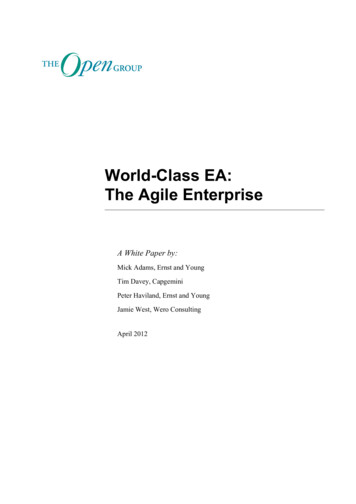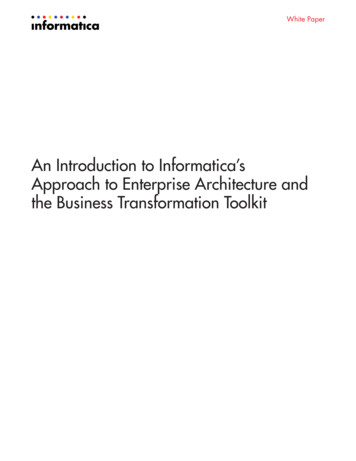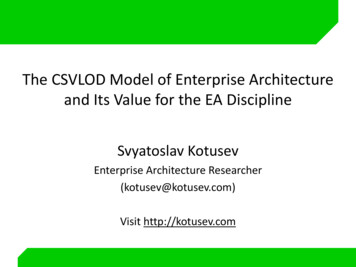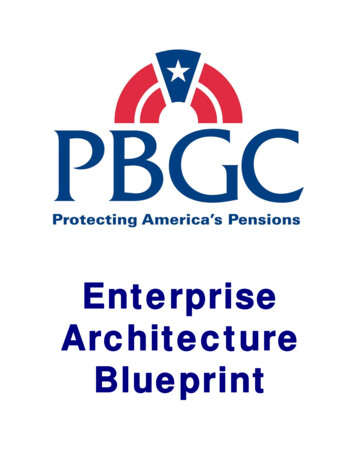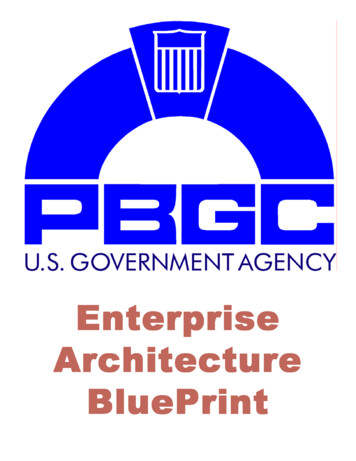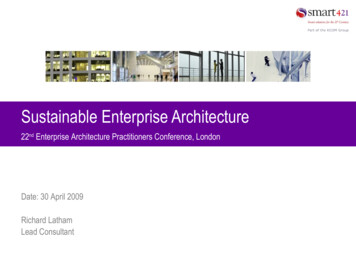
Transcription
Sustainable Enterprise Architecture22nd Enterprise Architecture Practitioners Conference, LondonDate: 30 April 2009Richard LathamLead Consultant
Sustainable Enterprise ArchitectureSustainability - Is the ability to maintain a certain process or state.Based upon real world experience fromour recent engagements - How wecreate and make EA work without unduestrain on resources of the Organisation MoneyPoliticalBearable Political Capital Change to the status Adapted from UCN. 2006. The Future of SustainabilitySustainable Enterprise Architecture London 30 April 20092
Key ideasYou do not need a big EA project to do EA A Moniker to popularise Architecture Identify and use Sources of Change Driving the creation and maintenance of the Architecture Creating demand for Architecture to improve it Guidance & Compliance Balancing Resource use and being Sustainable Continual improvementSustainable Enterprise Architecture London 30 April 20093
GovernanceOperating in the 4th quadrant of ADM – Phase G Implementation Governance Assumptions There is or will be a Vision There is or will be Strategy There is or will be a Roadmap There is or will be some ArchitectureSustainable Enterprise Architecture London 30 April 20094
Architecture as a Decision Spaceesci plTechnical Archda rdssPatternPattern sesi plcnPriDecisionSpacechArrc hndardschArnt iomaroInfSt anPrinStarchApplication Ar chchArTechnic alAnAti oamorInfsessi nBusessi nBuApp li cation ArchArchitecture defines the boundaries of acceptable solutions, i.e. the space in whichto make decisionsThe Decision SpaceSustainable Enterprise Architecture London 30 April 20095
Implementing IT strategy through ArchitectureMove the Decision Space to achieve the strategyEnterprise DevelopmentDimensionsof ITVisionTimeSustainable Enterprise Architecture London 30 April 20096
The Architecture RoadmapThe Roadmap sets the timetable for progressively changing the Architecture The Business Strategy feeds the IT Vision IT Vision is to be achieved by executing the IT strategy The IT Architecture Roadmap is derived from the IT Strategy and is the way thatArchitecture contributes to the achievement of the IT Vision The Architecture Roadmap moves the Decision Space in the direction of the IT strategyBusinessStrategyITVisionSustainable Enterprise Architecture London 30 April 2009ITStrategyArchitectureRoadmap7
Sources of change to the ArchitectureThere are two sources of chitectureEnterpriseArchitectureRe-useexistingRe- use existingartefactsartefactsProgramsPrograms/ nance Business Strategy - moves the Decision Space e.g. the principles, guidelines and standards Business Change – Creates programmes which change the architectureSustainable Enterprise Architecture London 30 April 20098
Sustainable ModelBuild the Architecture and benefit the Programmes by creating the Virtuous tureRe-useexistingRe- use existingartefactsartefactsProgramsPrograms/ nanceArchitectureUpdate Programmes use architecture to make decisions within the decision space Programmes feed the changes into the architectureSustainable Enterprise Architecture London 30 April 20099
Use the ArchitectureBoard involvement The Board are traditionally interested in 3 main attributes of Programmes: Managing Cost Managing the Schedule Benefits realisation (deployment) As the Board also owns the Vision and the Strategy they should also be interested in thefulfilment of their strategy The mechanism for implementing strategy is the programmes The programmes deliver within the Decision Space Board level approval should be the mandate for Programmes to comply with the Visionand Strategy. Use of the Architecture makes it easy for Programmes to comply with theStrategy – Embodied in the Architecture ContractSustainable Enterprise Architecture London 30 April 200910
Use the ArchitectureProgrammes use the ArchitectureSustainable Enterprise Architecture London 30 April eSTARTUPComplianceGuidance Establish touch points between Programmesand Architecture Report Programme / Architecture statusthrough end of phase programme reports The status report should be made to theboard, so that action can be taken if requiredANALYSISNon-blocking architecturereviews11
Project Touch PointsWhat are Architecture Touch-points? A touch-point is an interaction between a Programme and Architecture. Compliance reviews occur at the boundaries between project phases. Typically each touch-point has two parts: Guidance – An agreement between Architecture and the Programme that the programme will dothings and follow standards, strategies etc. If this agreement cannot be reached, then aconcession (to do something else) should be agreed Compliance – Usually a review, which should be recorded on a review sheet, conducted fromrecognised points of view with agreed actions as the outcome The Start-up touch creates the Architecture Contract Board Approval to Proceed must include architecture approval The Close touch point completes the cycle, the Head of Architecture accepts theArchitecture Artefacts delivered by the project The Close Touch-point provides time to review any concessions or dispensations and theactions to fix themSustainable Enterprise Architecture London 30 April 200912
Balancing Politics and EconomicsEngagement Model The engagement model aims to achieve the following: Credibility of architecture Sets expectations Projects Pay for their Architect The Architecture team aim to achieve the following KPIs: Reviews allocated on same working day as request is receivedX working days to deliver a review of an item1 working day to complete and verify changes and complete reviewEach review should include at least one hour available for meetingsAn arrival rate of Y items to review per daySustainable Enterprise Architecture London 30 April 200913
Balancing Politics and EnvironmentEngagement Model The engagement model aims to achieve the following: The existing project lifecycle is usedThe existing project processes are used, but modifiedThe existing reporting is used, but modified to add architecture statusThere is a record of the items that have been reviewedAnalysis of the reviews can be made Key Performance Indicators Architecture performs as agreed The Architecture team aim to provide assurance that The Programme delivers what is required The Architecture removes doubt and risk More reliable estimates & plansSustainable Enterprise Architecture London 30 April 200914
Balancing Environment and EconomicsEngagement Model The engagement model aims to achieve the following: Early engagement with Architecture is free and produces a clearer definition of the projectReduced risk of the project being rejected by the approval processThe cost of the Solution Architect is paid for by the projectImpact and gap analysis identify all of the major pieces of work and dependencies Key Performance Indicators The Architecture team aim to provide assurance that The Architecture removes doubt and riskMore reliable estimates & plansFaster DeliveryLess re-workSustainable Enterprise Architecture London 30 April 200915
Tactics to implement the ArchitectureMake sure that the Architecture is used Get feedback from its use to improve the Architecture Architecture improves the design and decision processes Creating touch points with programmes The Architecture team delivers a service within the KPI Responsive to requests for information & help Responsive to requests for changes Responsive to requests for reviews The use of Architecture artefacts by Programmes / Projects Faster delivery based on consistent information and re-use of modelsLower risk design within the decision space provided by the ArchitectureStandardisation of terms improves project qualityBetter communication using standard modelsSustainable Enterprise Architecture London 30 April 200916
2nd Phase – Improving the ArchitectureProjects improve the Architecture Programmes and Projects will raise change requests and add items to the backlog Projects will create and change architecture artefacts under change control Improve the artefacts The high priority items on the backlog should be given sufficient attention to be able to correct theerrors or fill the gaps Projects augment the Architecture with artefacts created by the project Improve the processes The touch points and communications are monitored against the SLA Templates and review perspectives used, reviewed and improvedSustainable Enterprise Architecture London 30 April 200917
3nd Phase – Increasing MaturityArchitecture improves Architecture The Architecture governance processes will be used to improve the Architecture.Measuring and reviewing performance against KPIs, the Roadmap and the IT Strategy Set up periodic reviews Review IT strategy against Business StrategyReview the Architecture Roadmap against IT Strategy and the current positionReview Architecture against the Roadmap – is progress being made in the right direction?Review output and performance of systems, services and applications in the light of Architecturedecisions & guidance (Is the Architecture guidance working?) Create & execute corrective actionsSustainable Enterprise Architecture London 30 April 200918
ArchPatternsesiplncPriDecisionSpaceTechnical Archda rdssPatternndardsSt anchArrchrc hnAesStat iomaorInfPrinci plchArTechnic alAApplicationorInfrchnAtiomasessi nBusessi nBuApplicationArchKey conceptsThe Decision hitectureEnterpriseArchitectureRe-useexistingRe- useexistingartefactsartefactsProgramsPrograms/ nanceSources of rogramss / geGovernanceArchitectureUpdateVirtuous CircleSustainable Enterprise Architecture London 30 April 200919
Conclusion Make it important to the Board (Stimulates Demand) Create Demand for Architecture (Grows the Architecture) Respond to the Demand (Maintains Political Capital) Create Project Touch-points (Maintain Environmental Capital) Govern the Architecture (Maintain Architecture Capital) Give projects the Responsibility for Creating and Modifying Enterprise Architecture Artefacts(Maintain Economic Capital) Create a Backlog (Maintain Political Capital) It is Hard to keep up with the Demand once you start itSustainable Enterprise Architecture London 30 April 200920
www.smart421.comFor more information on Enterprise Architecture, please visit our websiteCopyright 2009, Smart421. A copy of this presentation is available on requestRichard LathamLead Consultantrlatham@smart421.com
Sustainable Enterprise Architecture London 30 April 2009 2 Sustainable Enterprise Architecture Sustainability - Is the ability to maintain a certain process or state. Political Environmental Economic Sustainable Bearable Viable Equitable Adapted from UCN. 2006. The Future of Sustainability Based upon real world experience from




